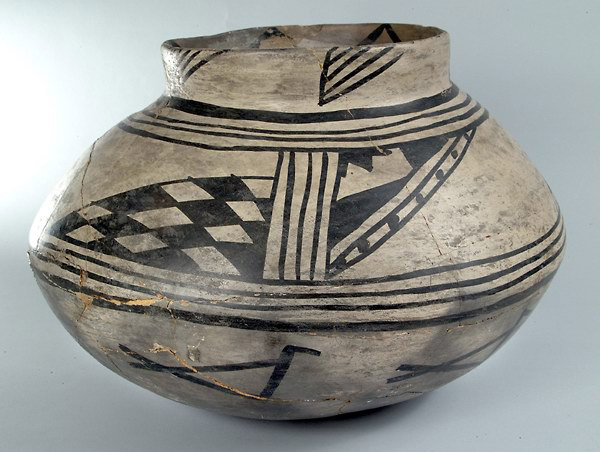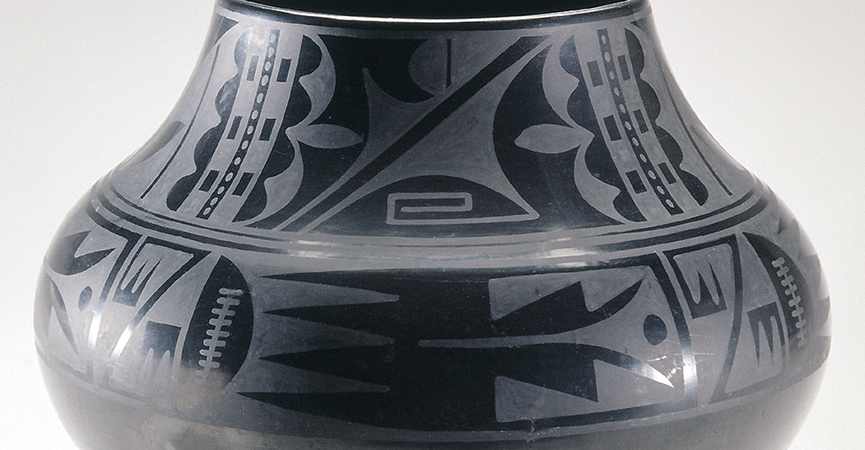Black-on-black ceramic vessel
Maria Martinez and Julian Martinez, Tewa, Puebloan, San Ildefonso Pueblo, New Mexico. c. mid-20th century C.E. Blackware ceramic
Maria Martinez and Julian Martinez, Tewa, Puebloan, San Ildefonso Pueblo, New Mexico. c. mid-20th century C.E. Blackware ceramic
They discovered that smothering the fire with powdered manure removed the oxygen while retaining the heat and resulted in a pot that was blackened. This resulted in a pot that was less hard and not entirely watertight, which worked for the new market that prized decorative use over utilitarian value. The areas that were burnished had a shiny black surface and the areas painted with guaco were matte designs based on natural phenomenon, such as rain clouds, bird feathers, rows of planted corn, and the flow of rivers.
- Completely Identify
- Date: 1939
- Artist: Maria Martinez and Julian Martinez
- Material: Blackware ceramic, pigment, volcanic ash
- Culture: Pueblo
- Location: New Mexico
- Context
- Although women did not have official religious/ceremonial roles and authority, Puebloan rituals centered on mimicking female reproductive ability, and women were afforded respect in the domestic sphere.
- Form
- Function
- Maria Martínez and Julian Martínez's pieces became known as fine art and were purchased from them as such.
- Historically, ollas and similar dishes held water, stored seed and grain, and were used for cooking.
- Content
- Vocabulary
- Olla: rounded pot.
- Matte: dull black.
- Burnished: polished with a stone (as opposed to being glazed).
- Themes
- Challenges traditions
- Images of (cultural) identity
- Objects of wealth and status
Maria Martínez's pottery is remarkable because she transformed a functional tradition of Puebloan pottery into symbols of her culture and works of decorative
art that became status symbols for many American collectors.
- Cross cultural connections
- Bushel with Ibex motifs
- Staff god/ god stick
- Puebloan pottery is typically a communal art where different people complete different steps.
- the staff god also incorporates work done by a group
- women made the bark cloth and men did the carving.
- Sources
National Parks Service https://www.nps.gov/museum/exhibits/band/contemporary.html
Khan Academy
Cincinnati Museum
JSTOR Article by M. Jane Young
- https://www.livingston.org/cms/lib9/NJ01000562/Centricity/Domain/1227/black%20on%20black%20Ceramic%20vessel.pdf
https://www.nps.gov/museum/exhibits/band/archeology.html
https://www.nps.gov/azru/planyourvisit/upload/Ceramics_Site_Bulletin.pdf
https://www.khanacademy.org/humanities/ap-art-history/indigenous-americas/a/puebloan-maria-martinez-black-on-black-ceramic-vessel
http://library.cincymuseum.org/topics/u/files/unionterminal/win-003.pdf
https://www.jstor.org/stable/540903?seq=1#metadata_info_tab_contents



